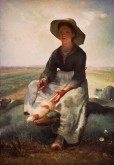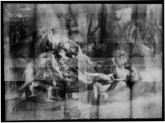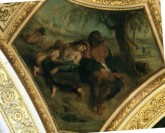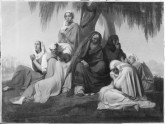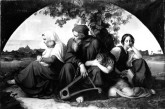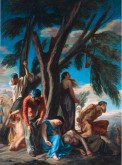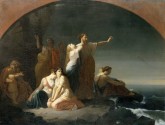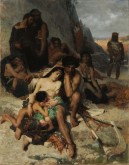The browser will either open the file, download it, or display a dialog.
In February of 1848, the July Monarchy of King Louis-Philippe was swept away by political and social discontent that reverberated in insurrections throughout Europe. Born on the ruins of the July Monarchy, the Second Republic opened with Romantic faith in the righteousness of the People. National workshops were established to stem the unemployment that had undermined the throne of Louis-Philippe. Suffrage, formerly restricted to an affluent sliver of the population, was extended to all adult males. In this spirit of equality and fraternity, all were welcome to exhibit in the unjuried Paris Salon of 1848, which opened in March. Benefitting from the vogue of nostalgic interest in the mores and traditions of the French provinces, Jean-François Millet won critical acclaim in that Salon with an imposing image of rustic labor, The Winnower (fig. 1).[1] Neither sentimental nor ingratiating, this broadly painted peasant in ill-fitting sabots would have received short shrift from a jury of the July Monarchy. In the previous Salon—following four years of rejection—the young painter from the rural Norman coast had exhibited Oedipus Taken Down From the Tree (National Gallery of Canada, Ottawa).[2] This unusual mythological subject, with its soft contours and foreshortened nude body, gave little warning of the forcefully sculptural anonymous peasants, which, following The Winnower, would be Millet’s stock and trade.
Millet’s friends, the artists Charles Jacque and Philippe-Auguste Jeanron (director of the Louvre), persuaded a collector of impeccable Republican credentials that the artist merited support. This was Minister of the Interior Alexandre-Auguste Ledru-Rollin, to whom Jeanron owed his appointment. Ledru-Rollin purchased The Winnower.[3] In June of 1849, Ledru-Rollin escaped to London after an attempted insurrection developed from a demonstration he had led against the president of the Second Republic, Louis-Napoleon Bonaparte.[4] During this exile, The Winnower was sold and subsequently lost.[5]
Part of the canon of nineteenth-century painting since its rediscovery in an American attic in 1972,[6] The Winnower overshadowed Millet’s other entry in the 1848 Salon. This was a Captivity of the Jews in Babylon, which was poorly received and subsequently painted over.[7] The subject, as we will see, was well worn at the time; it is based on Psalm 137: the lamentation of the Hebrews who refuse to play their national songs at the bidding of their captors.[8] The famous opening lines are elegiac:
By the rivers of Babylon—
there we sat down and there we
wept
when we remembered Zion.
On the willows there
we hung up our harps.
The following, defiant passage was included by Millet in the Salon livret:
For there our captors
asked us for songs,
and our tormentors asked for
mirth, saying,
“Sing us one of the songs of
Zion!”
How could we sing the LORD’s
song
in a foreign land?
If I forget you, O Jerusalem,
let my right hand wither!
Let my tongue cling to the roof of
my mouth,
if I do not remember you,
if I do not set Jerusalem
above my highest joy.
And the conclusion is ferociously vengeful:
Remember O LORD, against the
Edomites
the day of Jerusalem’s fall,
how they said, “Tear it down!
Tear it down!
Down to its foundations!”
O daughter Babylon, you
devastator!
Happy shall they be who pay
you back
what you have done to us!
Happy shall they be who take
your little ones
and dash them against the rock!
[9]
According to Millet’s friend and biographer, Alfred Sensier, the artist later painted over the Captivity with a Sheep Shearer.[10] He was nearly correct. In 1983, x-ray analysis of a Young Shepherdess (fig. 2)—the largest canvas among the plentiful Millet holdings in the Boston Museum of Fine Arts—exposed ghostly captive Hebrews and Babylonian tormentors; the original horizontal orientation had been turned ninety degrees.[11] In the x-ray image (fig. 3), published in 1984 by Alexandra R. Murphy, it is possible to discern, at the left, two or three soldiers. The foremost soldier bends forward, thrusting a harp toward a captive. She recoils, like Susanna before the elders, extending an arm in refusal. A second soldier grasps the drapery of another captive. The lack of clarity is not solely due to the limitations of the x-ray print. With the painting in full view, one critic characterized it succinctly: “Rough sketch in which the observer will search in vain for a precise form.”[12]
This faint visual evidence is enhanced by Sensier’s sympathetic recollection of the work after its disappearance. The painting was “beautifully composed and conceived in the manner of a master whom Millet had always loved, Nicolas Poussin”:
The canvas was easily two meters wide by one and a half in height. The deep, peaceful landscape was traversed by a wide river; and, in the rear ground, appeared the lofty towers of the walls of Babylon. The scene was skillfully arranged: a group of Assyrian solders—dressed more in the Roman than in the Asiatic manner—presented, with affectation, lyres to three women, each seated and veiled in black. One of them—young and beautiful—refused, with an expressive gesture, to bend to the bidding of the vanquisher. I can clearly remember that the arms of the women were admirable in grace and in movement, and that the black veils gave to the scene a moving and desperate aspect; the soldiers—mannered in pose and costume—dampened the touching view of the Jewish women. That was the defect of a painting, which, as you know, no longer exists.[13]
Sensier’s recollection of the soldiers blemishing his friend’s painting echoes Théophile Gautier’s distinction between The Winnower and the Captivity in his review of the Salon of 1848. Having praised The Winnower, Gautier waxed witty at Millet’s expense:
We are less fond of the Babylonian Captivity. The soldiers harry the Jewish women who refuse to sing the hymn of Zion in a foreign land with more violence than needed, given that it is merely a matter of refractory virtuosi. They would not act any differently in an assault or in a sack of a city. Monsieur Millet has surely interpreted this scene of musical coyness on the banks of the Euphrates in a manner too barbarous and vehement; and, as the fury of execution matches the convulsive energy of the composition, the result is that this thwarted concert resembles a massacre.[14]
The x-ray trace of the grotesque, foremost soldier corroborates these reservations. Nor did the rough facture of the painting sit well. Thus, one critic was dismayed that the artist seemed, in both Salon entries, to give to oil paintings “the matte aspect of encaustic covered with dust.” Such a laborious plastering of the surfaces was “more profitable for the color merchant than for the artist.”[15]
What, then, are we to make of this unfortunate painting? Sensier implied that the subject was biographically resonant. Prior to Millet’s departure for Paris from Normandy in 1837, the artist’s mother and grandmother “overwhelmed him with advice and entreaties, so that their poor child would avoid the seductions of that Babylon.” To this identification of Paris with the alluring iniquity of Babylon, Sensier added reference to the exile of the Jews. “Paris,” he noted, “while unavoidable for his career, marked but a sad and uneasy phase in which he had to spend, like a captive, the richest years of his life.”[16] Later commentators explicitly associated the plight of the artist with that of the captive Hebrews. Julia Cartwright held that “in this scene of the Jewish women refusing to play their harps in their captivity the painter has given utterance to his own sorrow, and to the yearning of his heart after his own land.”[17] Etienne Moreau-Nélaton concurred: “The verses of the sacred text that captioned the work in the catalog rang like an echo of the anguish that filled that most sensitive of hearts at the thought of his birthplace cut off by an impassible gulf.”[18]
These inferences are not mistaken. Drawn to Paris by ambition, Millet experienced the pain of exile when he arrived on a dreary winter evening:
I arrived in Paris on a snowy Saturday evening in January; the light of the streetlamps nearly extinguished by the fog, the huge numbers of horses and carriages colliding or intersecting, the narrow streets, the odor of the air of Paris went to my head and my heart to the point of suffocation. I broke into a flood of tears that I couldn’t stop. I wanted to master my feelings yet they ruled me with all of their might. . . . Paris seemed mournful and insipid. To get established I went to a furnished room where I spent my first night in a sort of ongoing nightmare: seeing my homeland, our sad house with my grandmother, my mother, and my sister spinning in the evening and crying while thinking of me and praying that I might escape downfall in Paris.[19]
The nightmare then transformed into a spectacle of artist’s own fierce ambition: “The cursed demon returned and pushed me before magnificent paintings, that I found so beautiful, so dazzling, that they seemed to burst into a blaze of glory and disappear in a heavenly cloud.”[20] On waking he was rudely brought back to earth. Finding that his room “was but a fetid, unlit hole” he fled out-of-doors, where he regained a sense of calm and of self-determination in the dawn air.[21] The artist’s unease in Paris eventually led to departure from the city. Fleeing a cholera outbreak in June of 1849, Millet permanently settled with his family in Barbizon.
There is no reason to doubt that the artist’s life experience had something to do with his choice of Psalm 137 as a subject to exhibit in the Salon of 1848. At the same time, I am skeptical that biography alone can explain the subject of the shunned painting. I contend that the work encompassed public discourse as well as private sentiment, and that Millet’s interest in the subject went well beyond homesickness.
In 1848, the Babylonian Captivity was hardly an unfamiliar subject. In the theology cupola of the Palais-Bourbon library, Delacroix had recently represented this biblical exile to signal the love of nation required of the legislators who consulted books from the stacks below (fig. 4). “A weeping family, seated on the bank of a river, sadly contemplates the water while thinking of the distant fatherland,” runs the published description by Théophile Thoré—probably supplied by Delacroix.[22] The poignancy of the painting and its description speaks to sensitivity toward exile. This had been an abiding aspect of national culture since the emigration during the French Revolution; it was stoked, under the July Monarchy by the mythic captivity of Napoleon and by the flight from Poland of refugees such as Delacroix’s friend Chopin.[23]
Delacroix’s painting projects a lassitude shared with other representations of the Babylonian Captivity dating from the July Monarchy. A version by Romain Cazes (fig. 5), for example, is characterized by inertia and self-absorption.[24] The prototype for such imagery was the Lamenting Jews in Exile by the Dusseldorf painter Eduard Bendemann (fig. 6). Bendemann’s painting was reproduced (1836) in a publication that brought modern German art to the attention of French readers.[25] None of these antecedents include, as does Millet’s work, taunting Babylonians. In this regard, Millet’s version had a precedent in The Last Stop of the Jews Led into Captivity in Babylon by Louis de Planet, Delacroix’s assistant in the decoration of the Palais-Bourbon library and friend to Roman Cazes (fig. 7). De Planet’s painting was exhibited in 1843 and, again, in the Salon of 1849. Just as these works of the July Monarchy set forth the sense of loss and enervation characteristic of post-Napoleonic culture—that mal du siècle diagnosed by Alfred de Musset in La Confession d’un enfant du siècle (1836)—so too did the ferocity of Millet’s version speak to the storm and stress of the period around 1848.
As a representation of suffering far from home, Captivity of the Jews in Babylon was not unique within Millet’s oeuvre. In this regard, the work bears affinity to two contemporary images of homeless misery. A cloaked mother and child wander a windswept waste in a small canvas in Denver.[26] For an unfinished painting commissioned by Ledru-Rollin’s Ministry of the Interior, Millet chose a heartrending subject from the Old Testament, Hagar and Ishmael languishing at death’s door (Mesdag Museum, The Hague).[27] As Robert Herbert has indicated, these two works of 1848-49 speak to the urgent mid-century theme of demographic disruption, whereby provincial villagers were abandoning rural communities for cities in fruitless search for work.[28] That bitter context is no less relevant to Millet’s Captivity of the Jews in Babylon.
The timeliness of Millet’s rendition of exiles in extremis is suggested by a painting exhibited in the Salon of 1849, The Exiles by Charles-Adolphe Richard-Cavaro (fig. 8). This work was commissioned by Ledru-Rollin’s Ministry of the Interior three days before Paris erupted in the violence of the 1848 June Days insurrection. Brutally suppressed, this workers’ revolt upended the idealism of the early Second Republic. In a letter to the ministry from the following March, Richard-Cavaro specified that the painting would have an “Effet sombre.”[29] The tone of the painting corresponds to the troubled climate in which it was commissioned and executed. At the water’s edge, a group of classically-garbed figures strike attitudes of desperation and sorrow. The praise won by this melancholy painting suggests that the drubbing received by Millet for the Captivity was a matter of handling, rather than subject. The critic Fabien Pillet was particularly impressed by the restrained gestures of the exiles.[30] The artist, a pupil of Ingres and Léon Cogniet, was careful to shelter the unfortunates within the propriety of classical costume and Ingresque quotation.[31]
The Exiles is, in fact, a Hellenized version of the Babylonian Captivity. This is made clear by Richard-Cavaro’s quotation, in the Salon livret, of a verse imitation of Psalm 137 by Jacques-Charles-Louis de Clinchamp de Malfilâtre (1733–67), one of several eighteenth-century poets who translated or imitated the psalms.[32] The passage from Malfilâtre is an example of a French reverence for Psalm 137 that was at least as old as Racine’s Esther, in which the chorus speaks the psalm. That Ancien Régime tradition acquired new relevance with the flight of the clergy and aristocracy during the Revolution. Consider the poem La Pitié (1803) by the Abbé Jacques Delille (1738–1813). A fugitive from the Revolution, Delille likened the sorrows of the émigrés to those of the captive Hebrews in Babylon.[33] Similarly, in the previous year, with characteristic grasp of the national mood, Chateaubriand took advantage of the proclamation of the Concordat with the Vatican to cast himself in the role of a Hebrew delivered from Babylon. With feigned modesty, in the preface to the first edition of Le Génie du christianisme, the recently returned exile lent providential significance to his paean to the beauties of the faith by invoking the redemption of Jerusalem: “As for myself, obscure Israelite, I bring today my grain of sand, in order to hasten, as much as it is in my power, the reconstruction of the Temple.”[34]
Deeply rooted in French art and letters, Millet’s biblical subject may have borne relevance to unfinished business from Millet’s brief stint at the Ecole des Beaux-Arts. There, his rendition of Saint John Preaching in the Desert had been eliminated in the first round of the 1839 Prix de Rome competition.[35] The Captivity may have been a final attempt to traffic in history painting. At the same time, the position of the work vis-à-vis grand manner history painting is complex. An attempt to undo failure at the Ecole des Beaux-Arts is suggested by the comeliness of the Hebrew women, praised by Sensier and—at more of an arm’s length—by Gautier. At the same time, the forcefulness of the ungainly foremost Babylonian tormentor in pompier helmet hints at deliberate overstatement. The open Salon of 1848 could have offered Millet an opportunity to provoke the academicians with an exaggerated example of l’expression—a criterion by which the lofty subjects treated by Prix de Rome contestants were judged.[36]
Nor would this have been the first time that Millet turned to the Old Testament for imagery at once grandiose and aggressive. In 1841, Millet closed a patronage dispute with the Municipal Council of Cherbourg by offering to his antagonists a Self-portrait as Moses (Musée Thomas-Henry, Cherbourg).[37] The Council had denied payment to Millet after it judged a commissioned portrait of a deceased mayor a poor likeness. The artist’s self-esteem was already uncomfortably entwined with municipal resources: Millet’s sojourn in Paris—where he dropped out of the Ecole des Beaux-Arts after the Prix de Rome debacle—had been underwritten by a bourse. Given by the city to this talented youth from the local countryside, the scholarship had been withdrawn when Millet left the official art school. Accompanied by a letter penned with transparently mock humility, the Self-portrait as Moses invoked the Romantic notion—a commonplace of utopian rhetoric in 1840s Paris—that invested the artist and poet with lawgiving authority. Whereas that odd painting conveyed angry self-assertion in biblical terms, Captivity of the Jews in Babylon couched wounded self-regard in bluster.
Millet and Richard-Cavaro were not unique in their attraction to Psalm 137 around 1848. The psalm is also mentioned in a startling account by the mystical socialist poet and collector of Parisian institutional mores, Alphonse Esquiros (1812–76), of a recital, during Holy Week, of the lamentation over the Babylonian Captivity by the chorus of Racine’s Esther. In performance were the female mental patients of La Salpêtrière hospital. Mindful of the downbeat liturgy of that week, Esquiros fruitlessly attempted to analyze his excited response:
This contrast between past and present; the ruins of Jerusalem placed beside these devastated souls; a destroyed city, human reason without light; a chosen city, whose glory is but dust; women whose beauty is but a shade, all of these images blended for this listener amid a feeling that cannot be analyzed. . . . I believe that I can still hear those exiles from reason say, in figurative speech, and in a voice I have heard nowhere else, their lamentations, their regrets, their distant longings. To return to reason, for the soul, that is to return to the fatherland. How many madwomen of La Salpêtrière go about searching for that homeland in the sky?[38]
This passage resonates with that longing for the future and unease with the present, which underlie the dreams of regenerating humanity brought to July Monarchy Paris by Esquiros and other Romantic social thinkers.[39] The irrepressible train of analogies let loose by Esquiros stems from the protean vitality of Psalm 137 in the year that Millet exhibited Captivity of the Jews in Babylon.
So far, I have been arguing that Millet’s decision to represent the Babylonian Captivity was surprisingly fraught. Indeed, the choice appears overdetermined. As indicated by the artist’s biographers, Sensier, Moreau-Nélaton, and Cartwright, the subject was germane to Millet’s longing for his Norman home. It also recalled his painful introduction to Paris, which, in its association with artistic temptation, could have seemed a modern Babylon. Asserting his presence at the 1848 Salon with an ambitious history painting, the homesick artist pushed expression beyond the bounds of academic decorum. The vehemence of the painting—which so annoyed Gautier—speaks of the urgency with which the subject was imbued around 1848. The point is corroborated by the gloom of The Exiles by Richard-Cavaro and by Alphonse Esquiros’s haunting account of the performance by the madwomen of La Salpêtrière hospital. Along with Millet’s contemporary images of homeless wanderers, Captivity of the Jews in Babylon blends with a somber backdrop of mid-century demographic disruption and unemployment. Nor was the subject novel. Under the July Monarchy there had been a number of downbeat representations of the Babylonian Captivity. These evoke the sense of loss and lassitude that comprise the other side of the coin from the utopian ferment that Millet would have encountered in the capital. Embedded in French literary tradition since the seventeenth century, Psalm 137 spoke to a legacy of sensitivity toward exile, manifest, at the opening of the nineteenth century, in counter-revolutionary parallels, posited by Delille and Chateaubriand, between the Babylonian Captivity and the sorrows of recent French history. That Millet’s painting had so complex a genealogy leads me to reflect on the artist’s decision to repaint the canvas with a Young Shepherdess.
The practicality of the move is clear enough. In August of 1870, seeking refuge from the Franco-Prussian War, Millet returned to the Norman seaboard. Holed up in Cherbourg, he was cut off from art supplies. In need of canvas, Millet removed the large Captivity of the Jews in Babylon from long-term storage and recycled it. [40] With the passage of two decades, the biographical, social, and cultural dimensions of the earlier painting were no longer relevant. Obliterating a frustrated example of aspiration toward grand-manner narrative, the new painting (fig. 2) has the sculptural heft and generalized features characteristic of Millet’s peasant imagery. We look up at the shepherdess, her broad-brimmed hat silhouetted in diffuse sunlight. Seated on a mound, she looms above two diminutive sheep, her waist meeting the horizon.[41] This imposing figure poignantly affirms Millet’s attachment to rural France in the aftermath of the Terrible Year of 1870-71.
Whereas Millet abandoned the Babylonian Captivity, Psalm 137 was honored at the Ecole des Beaux-Arts where it provided the subject of the Prix de Rome competition of 1873. The winner, Aimé-Nicolas Morot, represented the exiles huddled in despair under armed guard (fig. 9). A muscle-bound father, his ankles and one wrist shackled to the riverbank, a harp at his feet, sits in the foreground. Striking a conventional attitude of melancholy, he supports a languishing mother. Young siblings squirm on her lap, their contrasting complexions matching those of the parents. This tearful image of two captive generations carried patriotic appeal following the recent national defeat and loss of territory.[42] Painted in a climate of anti-German animus, Morot’s image of captivity perpetuated—with inadvertent irony—a pictorial tradition pioneered in Dusseldorf. And it updated, in crowd-pleasing terms, the subject that Millet had exhibited with so little success in the Salon of 1848.
I am grateful to Michael Zell, Petra ten-Doesschate Chu, Robert Alvin Adler, and to an anonymous reviewer for Nineteenth-Century Art Worldwide for their thoughtful suggestions.
All translations are by the author.
[1] Robert L. Herbert, Jean-François Millet, exh. cat. (London: Arts Council of Great Britain, 1976), cat. no. 26. For Millet, see also Maura Coughlin, “The Artistic Origins of the French Peasant-Painter Jean-François Millet: Between Normandy and Barbizon,” (PhD diss., New York University, 2001); Alexandra R. Murphy, Jean-François Millet: Drawn into the Light, exh. cat. (Williamstown: Sterling and Francine Clark Art Institute; New Haven: Yale University Press, 1999); Alexandra R. Murphy and others, Jean-François Millet, exh. cat. (Boston: Museum of Fine Arts, 1984); Griselda Pollock, Millet (London: Oresko Books, 1977); Etienne Moreau-Nélaton, Millet raconté par lui-même, 3 vols. (Paris, Henri Laurens, 1921); Julia Cartwright (Mrs. Henry Ady), Jean Francois Millet, His Life and Letters (London: Swan Sonnenschein; New York: Macmillan, 1896; repr., New York: AMS, 1971); and Alfred S. Sensier, La Vie et l’oeuvre de J.-F. Millet (Paris: A. Quantin, 1881).
[2] Herbert, Millet, cat. no. 21.
[3] Ibid., cat. no. 26.
[4] Encyclopædia Britannica Online, s. v. "Alexandre-Auguste Ledru-Rollin," accessed January 18, 2014, http://www.britannica.com/EBchecked/topic/334511/Alexandre-Auguste-Ledru-Rollin.
[5] Herbert, Millet, cat. no. 26.
[6] See Kenneth Lindsay, “Millet’s Lost Winnower Rediscovered,” Burlington Magazine 116, no. 854 (May 1974): 239–45.
[7] Herbert, Millet, cat. no. 26.
[8] For representations of the Babylonian Captivity, see Jonathan P. Ribner, Broken Tablets: The Cult of the Law in French Art from David to Delacroix (Berkeley: University of California Press, 1993), 124–28; Jonathan P. Ribner, “Le Peuple de Dieu: Old Testament Motifs of Legislation, Prophecy, and Exile in French Art between the Empires” (PhD diss., New York University, 1986), 126–42; and Michael Seymour, “The Babylonian Captivity in Art and Culture,” in Babylon: Myth and Reality, ed. I. L. Finkel and M. J. Seymour, exh. cat. (London: British Museum Press, 2008), 150–53.
[9] The Holy Bible, Containing the Old and New Testaments, New Revised Standard Version (Oxford and New York: Oxford University Press, 1977), 639.
[10] Sensier, La Vie et l’oeuvre de J.-F. Millet, 107. For Sensier as biographer of Millet, see Christopher Parsons and Neil McWilliam, “‘Le Paysan de Paris’: Alfred Sensier and the Myth of Rural France,” Oxford Art Journal 6, no. 2 (1983): 38–58.
[11] For the Captivity of the Jews in Babylon and the Young Shepherdess, see Murphy and others, Jean-François Millet, cat. no. 141. For the Young Shepherdess, see also Herbert Millet, cat. no. 90.
[12] “Pochade dans laquelle l’oeil du public cherche en vain une forme précise.” Fabien Pillet, “Salon de 1848,” Moniteur universel, April 11, 1848.
[13] “La toile avait bien deux mètres de large sur un et demi de hauteur. Le paysage, profond et tranquille, était traversé par un large fleuve; et, sur le troisième plan, apparaissaient les hautes tours des murailles de Babylone. La scène était savamment disposée: un groupe de soldats assyriens, vêtus plutôt à la romaine qu’à l’asiatique, présentait avec affectation des lyres à trois femmes assises et voilées de noir. L’une d’elles, jeune et belle, refusait par un geste expressif de céder à la prière du vainqueur. Il me reste bien présent à la mémoire que les bras des femmes étaient admirables de grâce et de mouvement, et que les voiles noirs donnaient à cette scène un caractère émouvant et désespéré; les soldats, maniérés dans leurs attitudes et leurs costumes, atténuaient le spectacle touchant des femmes juives. C’était là le défaut d’une peinture qui, on le sait, n’existe plus.” Sensier, La Vie et l’oeuvre de J.-F. Millet, 106–7.
[14] “Nous aimons moins la Captivité de Babylone. Les soldats pressent les Juives qui se refusent à chanter l’hymne de Sion sur la terre étrangère avec plus de violence qu’il ne convient, lorsqu’il s’agit seulement de virtuoses récalcitrantes. Ils ne se conduiraient pas autrement dans un assaut ou dans un sac de ville. Cette scène de coquetterie musicale au bord de l’Euphrate est vraiment prise par M. Millet dans un sens trop barbare et trop véhément; et, comme la furie de l’exécution répond à l’énergie convulsive de la composition, il s’ensuit que ce concert manqué rassemble à une tuerie.” Théophile Gautier, “Salon de 1848,” La Presse, May 2, 1848.
[15] A. J. Du Pays, “Salon de 1848,” L’Illustration 11, 1848.
[16] Sensier, La Vie et l’oeuvre de J.-F. Millet, 43.
[17] Cartwright, Jean Francois Millet, 83.
[18] “Les versets du texte sacré qui commentent l’ouvrage dans le catalogue sonnent comme un écho de l’angoisse qui s’empare du plus sensible des coeurs à la pensée de la terre natale dont un abîme infranchissable le tient éloigné.” Moreau-Nélaton, Millet 1:68.
[19] “Ce fut un samedi de janvier que j‘arrivai le soir à Paris, par la neige; la lueur des réverbères presque éteints par le brouillard, la quantité immense de chevaux et de voitures qui se heurtaient ou s’entrecroisaient, les rues étroites, l’odeur et l’air de Paris, me portèrent à la tête et au coeur, au point de me suffoquer. Je fus pris par une crise de sanglots que je ne pouvais arrêter. Je voulais être plus fort que ma sensation et elle me dominait de toute sa puissance. . . . Paris me paraissait lugubre et fade. Pour mon entrée, je m’en allai à un hôtel garni où je passai ma première nuit dans une sorte de cauchemar continuel; revoyant mon pays, nôtre maison bien triste avec ma grand’mère, ma mère et ma soeur filant le soir en pleurant et songeant à moi et priant pour m’échapper à la perdition de Paris.” Quoted in Sensier, La Vie et l’oeuvre de J.-F. Millet, 44–45.
[20] “Puis le maudit démon revenait et me poussait devant de magnifiques toiles, que je trouvais si belles, si éclatantes, qu’il me semblait les voir s’enflammer dans une gloire et disparaître dans un nuage céleste.” Ibid., 45.
[21] Ibid., 45.
[22] “Une famille éplorée, assise au bord du fleuve, contemple douloureusement les flots en pensant à la patrie absent.” Théophile Thoré, “Les Peintures de la Bibliothèque de la Chambre des députés,”Le Constitutionnel, January 31, 1848.
[23] Such was the sensitivity toward exile that, even within the dry confines of a household encyclopedia entry, this term elicited raw emotion: “Partout . . . un intérêt généreux s’attache au pas de l’exilé; on s’émeut à sa vue, et c’est alors surtout qu’on sent combien il est à plaindre celui qui doit trainer son existence sur une terre étrangère, loin de la tendre mère qui le porta dans son sein et le nourrit de son lait, loin d’un père à cheveux blancs qui se penche vers la tombe et qui craint de mourir sans avoir revu son fils!” Encyclopédie des gens du monde: Répertoire universel des sciences, des lettres et des arts; avec des notices sur les principales familles historiques et sur les personnages célèbres, morts et vivans; par une société de savans, de littérateurs et d’artistes, français et étrangers (Paris, 1838), 10:350.
[24] The painting by Cazes was brought to my attention by Christopher Riopelle.
[25] Comte Athanse Raczynski, Histoire de l’art moderne en Allemagne (Paris, 1836), 1:146. From Bendemann there was also the tearful, introspective, and immobile Jeremiah on the Ruins of Jerusalem. This destroyed painting, which won a gold medal at the Salon of 1837, was reproduced in L’Artiste, 1st ser., 13, 1837.
[26] Herbert, Millet, cat. no. 28.
[27] For this painting, and for other representations of Hagar and Ishmael from the July Monarchy, see Jonathan P. Ribner, “Wandering in the Wilderness under Louis-Philippe," in Moving Forward, Holding Fast: The Dynamics of Nineteenth-Century French Culture, ed. Barbara T. Cooper and Mary Donaldson-Evans (Amsterdam: Rodopi, 1997), 131–50. For the Hagar and Ishmael, see also T. J. Clark, The Absolute Bourgeois: Artists and Politics in France, 1848–1851 (Greenwich, CT: New York Graphic Society, 1973), 75–77; and Bruce Laughton, “Millet’s ‘Hagar and Ishmael,’” Burlington Magazine 121, no. 920 (November 1979): 700–711.
[28] Herbert, Millet, cat. no. 28.
[29] The commission, from the Ministry of the Interior (June 20, 1848) for 1000 francs—twice the amount Ledru-Rollin had paid for The Winnower—was for a painting, whose subject and esquisse were to be submitted for approval. In a letter (March 27, 1849), the artist submitted the subject as Les Exilés, together with a passage from Malfilâtre. Following the passage, Richard-Cavaro indicated: “Effet sombre. Demandé.” F21 53, dossier 12, Archives Nationales, Paris [emphasis in original]. In the absence of documentation, one can only surmise that this aspect of the painting had been requested by the ministry headed by Ledru-Rollin.
[30] “Composition d’un genre sévère; figures demi-nature, bien drapés et d’un bon goût de dessin; couleur triste, analogue au sujet; touche pure et moelleuse; expressions beaucoup plus touchantes que si l’auteur avait voulu exagérer la douleur de ces nobles et généreux bannis.” Fabien Pillet, “Exposition de 1849 au palais des Tuileries,” Le Moniteur universel, August 7, 1849.
[31] The central, beseeching woman recalls the defenseless beauty in Ingres’s Roger Freeing Angelica (Louvre, 1819). A bearded man, who could comfortably stand among the classical greats in the Apotheosis of Homer, provides the apex of the triangle braced by quotations from, on the right, Ingres’s pupil Hippolyte Flandrin’s knee-holding Figure by the Sea (Louvre, 1836), and on the left by a child clutched like the youth in David’s Belisarius.
[32] For Malfilâtre and other members of this cohort, see Paul Bénichou, Le Sacre de l’écrivain, 1750–1830: Essai sur l’avènement d’un pouvoir spirituel laïque dans la France moderne, 2nd ed. (Paris: José Corti, 1985), 84.
[33] Having paraphrased Psalm 137, the poet moved seamlessly from biblical history to modern France: “Ainsi pleuroit l’Hébreu; mais du moins par ses frères / Il n’étoit point banni du séjour de ses pères. / Ah! combien du Français le sort est plus cruel! / Chassé par des Français loin du sol paternel, / Il fuit sous d’autres cieux; et, pour comble de peine, / De sa patrie ingrate il emporte la haine.” Jacques Delille, La Pitié, poëme (Paris: Giguet et Michaud, 1803), 100.
[34] “Pour moi, obscur Israélite, j’apporte aujourd’hui mon grain de sable, afin de hâter, autant qu’il est en mon pouvoir, la reconstruction du Temple.” Génie du christianisme, ed. P. Reboul (Paris: Garnier-Flammarion, 1966), 2:399.
[35] The work, in a private Parisian collection, is reproduced in Philippe Grunchec, Le Grand Prix de peinture: Les Concours des Prix de Rome, 1797 à 1863 (Paris: Ecole Nationale Supérieure des Beaux-Arts, 1983), 230.
[36] Alexandra Murphy indicates that the emphatic emotional expression of Captivity of the Jews in Babylon was echoed in four drawings that Millet provided in 1851 for a set of lithographs illustrating the life of Daniel Boone. See Murphy and others, Jean-François Millet, 41.
[37] For Millet’s Self-Portrait as Moses, see Ribner, Broken Tablets, 38–42.
[38] “Ce contraste entre l’état passé et l’état présent; les ruines de Jérusalem à côté de ces âmes dévastées; une cité éteinte, une raison humaine dont l’éclat est obscurci; une ville choisie, dont la gloire n’est plus que poussière; des femmes dont la beauté n’est plus qu’une ombre, toutes ces images se confondaient pour l’auditeur dans un sentiment qui ne s’analyse pas. . . . Je crois encore entendre ces exilées de la raison dire dans un langage figuré, et avec une voix que je n’ai point entendu ailleurs, leurs plaints, leurs regrets, leurs lointaines espérances. Revenir à la raison, pour l’âme, c’est revenir à sa patrie. Combien de folles de la Salpêtrière s’en vont cherchant cette patrie-là au ciel.” Alphonse Esquiros, “La Semaine-Sainte,” L’Artiste, 5th ser. 1, April 30, 1848.
[39] For Esquiros, see Paul Bénichou, Le Temps des prophètes: Doctrines de l’âge romantique (Paris: Gallimard, 1977), 448–53.
[40] See the account of the repainting in Murphy and others, Jean-François Millet, cat. no. 141.
[41] In its monumentality and contre-jour disposition, the painting is akin to Norman Milkmaid of Gréville (1874, Musée d’Orsay), for which see Maura Coughlin, “Millet’s Milkmaids,” Nineteenth-Century Art Worldwide 2, no. 1 (Winter 2003), accessed October 24, 2013, http://www.19thc-artworldwide.org/winter03/millets-milkmaids.
[42] The association of this painting with the defeat was suggested by Kirk Varnedoe. Just as the Babylonian Captivity was now the province of the Prix de Rome so, too, did nationalist biblical typology endure in at least one provincial town. Thus, Les Lamentations du prophète Jérémie traduites en vers français et suivies de quelques chants religieux et patriotiques composés à l’occasion de la guerre de 1870–71 entre la France et l’Allemagne (Troyes, 1871) is prefaced: “Or, quoi de plus semblable aux malheurs de la France en 1870 et 1871, que les malheurs de la Judée dans les nombreuses invasions qui l’ont si souvent ravagée et désolée sous plusieurs de ses rois.” In the spirit of the postwar Moral Order, the publication blames the national disaster on atheism.



